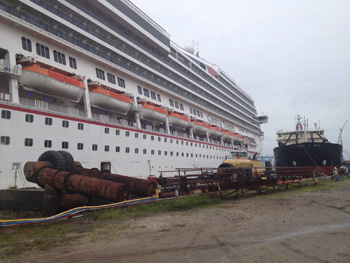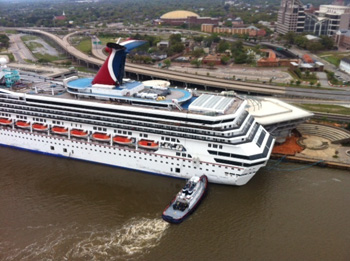Federal investigators say mooring bollards that failed in rapid succession during strong winds caused a cruise ship to break away from a Mobile, Ala., shipyard and collide with two other vessels.
Carnival Triumph was undergoing repairs at Pier K of the BAE Systems Mobile facility when it broke away on April 3, 2013. The 893-foot Carnival Corp. ship drifted across the Mobile River and collided with a tugboat and a dredger. One BAE Systems worker was injured and another later died when part of an adjacent pier collapsed.
National Transportation Safety Board (NTSB) investigators learned several mooring bollards on Pier K showed extreme wear almost three years before the accident. BAE Systems, which had commissioned the engineering report in 2010, apparently knew the bollards were in poor condition but did not tell Carnival officials, the NTSB report said.
“The probable cause of the breakaway of the Carnival Triumph from its moorings and the subsequent collision with the dredge Wheeler and the towing vessel Noon Wednesday was the successive failure of multiple mooring bollards, which were known by BAE Systems to be in poor condition with an undetermined mooring load capability,” the NTSB wrote.
A corporate spokesman for BAE Systems did not return messages seeking comment on the NTSB’s findings. Messages left for Carnival’s media relations staff also were not returned.
 |
|
The damaged dredge Wheeler is tied up alongside the ship. |
Triumph lost power and propulsion after an engine room fire on Feb. 10, 2013. The ship drifted in the Gulf of Mexico for days, and deteriorating conditions aboard the vessel became a focus of the national media. It was towed to Mobile, where passengers disembarked on Feb. 14.
Triumph was docked port side to Pier K during repairs at the Mobile shipyard. It was secured by at least 20 mooring lines made from eight-strand, 68-mm-diameter high strength co-polymer mooring lines, the report said.
“Forward on the ship, 10 mooring lines were used (six head, two breast and two spring lines), affixed to four bollards,” the report said. “Aft on the ship, another 10 mooring lines were used (in this case, four head, four breast and two spring lines), also affixed to four bollards.”
Three work barges were tied to Triumph’s starboard side and to Pier J.
At 1328, a passing storm front brought winds of 25 to 55 mph, with gusts of 65 mph. The unexpectedly strong winds pushed Triumph’s stern in a northwesterly direction away from the pier, putting tremendous strain on the mooring lines, the report said.
“Three aft mooring bollards parted from their mounts on Pier K, one stern winch paid out off its line under strain, and another line parted, setting the stern of the ship adrift,” the report said.
A fourth bollard broke free from its mount moments later. Other connections were severed and the vessel went adrift in the Mobile River.
Triumph’s crew requested help over the radio, and the tug Noon Wednesday responded. As the cruise ship drifted west across the river with one work barge still connected, the 4,200-hp Noon Wednesday positioned itself forward of amidships and began pushing against the hull, the report said. It wasn’t enough.
The crew dropped both anchors, which slowed the cruise ship but didn’t stop it.
Crew aboard the 387-foot dredge Wheeler, which was undergoing repairs across the river at the Signal Ship Repair facility, monitored the approaching cruise ship. At about 1350, when a collision was imminent, Wheeler’s master ordered everyone off.
“The Carnival Triumph’s starboard bow collided with the starboard side of the Wheeler. The starboard stern of the Carnival Triumph, and the attached work barge, came to rest on a fender system and the west bank of the Mobile River,” the report said. “The towing vessel Noon Wednesday became pinned between the hulls of the Carnival Triumph and the Wheeler.”
All three vessels were damaged in the accident.
Triumph sustained damage to its hull and promenade deck along with distortion of its vertical and horizontal frame, the report said. Repairs were expected to cost $2.7 million.
Wheeler sustained hull damage and distortion of its framing. Dredging equipment on the main deck was damaged. Repairs were estimated at $200,000. Noon Wednesday had minor damage estimated at about $3,000.
Two workers were thrown into the water when an end section of Pier J collapsed during the breakaway. Investigators aren’t sure if Triumph’s stern made contact with this pier or if extreme tension in the mooring lines connecting the three work barges to the pier caused the collapse. One worker was rescued from the water, but the other died. The federal Occupational Safety and Health Administration is investigating the incident.
In June 2010, BAE Systems hired an engineering firm to conduct a review of Piers K and H. The firm found that bollard mounting hardware was poorly attached to Pier K, and that hardware attaching the bollards to the deck were corroded. The firm suggested additional tests to determine Pier K’s mooring load capacity, including its capacity during heavy weather, but the NTSB report said those tests were never done.
“The overall condition of Pier K was deemed ‘poor,’” the NTSB report said. Investigators say BAE Systems did not disclose the state of the pier to Carnival personnel.
After the accident, tests of the anchor bolt sections of the failed bollards showed multiple problems.
“The evaluation report identified three types of rupture conditions as being present in the bolt specimens: brittle fracture, ductile rupture and severe corrosion prior to ductile rupture,” the report said.
Triumph underwent about two months of repairs and renovations after the accident. It returned to service in June 2013.

